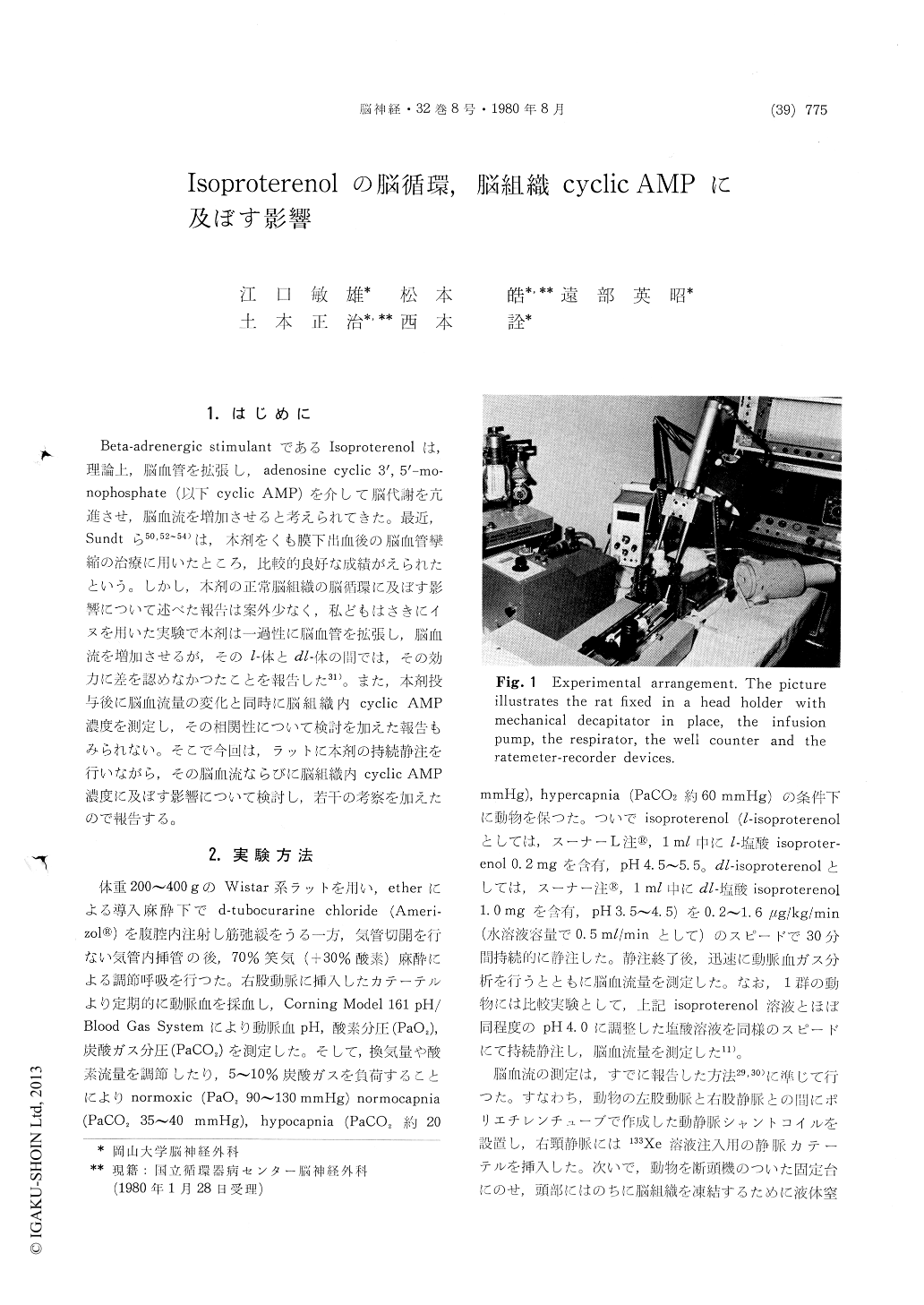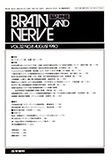Japanese
English
- 有料閲覧
- Abstract 文献概要
- 1ページ目 Look Inside
1.はじめに
Beta-adrenergic stimulantであるIsoproterenolは,理論上,脳血管を拡張し,adenosine cyclic 3′,5′—mo—nophosphate (以下 cyclic AMP)を介して脳代謝を亢進させ,脳血流を増加させると考えられてきた。最近,Sundtら50,52〜54)は,本剤をくも膜下出血後の脳血管攣縮の治療に用いたところ,比較的良好な成績がえられたという。しかし,本剤の正常脳組織の脳循環に及ぼす影響について述べた報告は案外少なく,私どもはさきにイヌを用いた実験で本剤は一過性に脳血管を拡張し,脳血流を増加させるが,そのl—体とdl—体の間では,その効力に差を認めなかつたことを報告した31)。また,本剤投与後に脳血流量の変化と同時に脳組織内cyclic AMP濃度を測定し,その相関性について検討を加えた報告もみられない。そこで今回は,ラットに本剤の持続静注を行いながら,その脳血流ならびに脳組織内cyclic AMP濃度に及ぼす影響について検討し,若干の考察を加えたので報告する。
Isoproterenol, a beta-adrenergic stimulant, has two isomers and its racemic compound. Recently, Sundt et al. reported an effectiveness of iso-proterenol in the treatment of vasospasm following subarachnoid hemorrhage. Since then, it has been well accepted isoproterenol has a vasodilatation effect on the cerebral vessels. But many reports suggest its influence on cerebral circulation in normal brain is still contraversial. In the previous paper, we investigated the influence of two types of isoproterenol (l- and dl-isoproterenol) on cere-bral circulation in dogs. Our experimental data suggested that both l- and dl-isoproterenol directly dilate the cerebral vessels and that we could not find out any difference between the effects of both of them on cerebral circulation.
The present study was designed to evaluate the effects of isoproterenol on cerebral circulation and tissue metabolism. Differences of effects between l- and dl-isomers of isoproterenol were also studied. Hemispheric blood flow (HBF) and concentration of adenosine 3´,5´-monophosphate (cyclic AMP) in brain tissue were measured in 99 Wistar strain rats under light nitrous oxide anesthesia.
HBF was measured by the modified Xe-133 tissue direct count method. Advantage of this method enabled to measure HBF and tissue metabolic variables simultaneously, even among the small animals. Cyclic AMP was measured by using the YAMASA cyclic AMP radioimmunoassay kits.Control values of HBF and cyclic AMP at normocapnia (PaCO238.9±0.6mmHg) were 83.3±2.4 ml/100 g/min and 1.26±0.05μmol/mg re-spectively. (All values indicate mean±standard error.) Similarly those at hypocapnia (PaCO2, 20.7± 0.5 mmHg) were 62.5±2.2 ml/100g/min and 1.26±0.07 μmol/mg respectively, and those at hypercapnia (PaCO263.6±1.4mmHg) were 139.6±5.8ml/100g/ min and 1.33±0.10μmol/mg respectively.
During normocapnia and hypocapnia, continuous intravenous administration of isoproterenol (0.4μg/kg/min) for 30 minutes caused significant increase in both HBF and cyclic AMP, while mean arterial blood pressure fell considerably. Both l- and dl-isomers of isoproterenol similarly increased HBF ranging from 128% to 140% of control values. The amount of increase in cyclic AMP was from 130% to 144%. A correlation between HBF and cyclic AMP values in individual animal was statistically good at normocapnia. On the other hand, during hypercapnia HBF did not show any changes, while cyclic AMP increased.
Administration of l-isoproterenol in different doses (0.2,0.4 and 1.6μg/kg/min) demonstrated dose-dependent increase in cyclic AMP, but increase in HBF was not dose-dependent.
Continuous administration of hydrochloric acid solution which was dispensed to same acidity as isoproterenol hydrochloride (pH 3.5-5.5) increased HBF without associated changes of cyclic AMP. This result suggests that arterial acidosis induced by either isoproterenol or hydrochloric acid solution is at least partially responsible for increase of HBF.
From these results, it was concluded that increase in the regional cerebral blood flow during intra-venous administration of isoproterenol may be mediated not only via direct vasodilating effect on the cerebral vessels, but also through enhancement of cerebral metabolism, especially stimulation of adenyl cyclase-cyclic AMP system.

Copyright © 1980, Igaku-Shoin Ltd. All rights reserved.


